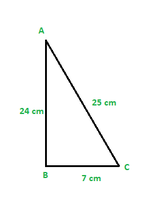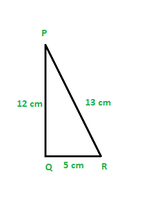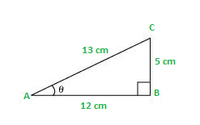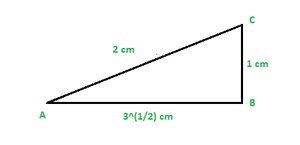Class 10 NCERT Solutions- Chapter 8 Introduction To Trigonometry – Exercise 8.1
Last Updated :
11 Dec, 2020
Question 1. In ∆ ABC, right-angled at B, AB = 24 cm, BC = 7 cm. Determine :
(i) sin A, cos A (ii) sin C, cos C
Solution:

Using Pythagoras theorem for ΔABC
AC2 = AB2 + BC2
= (24 cm)2 + (7 cm)2
= (576 + 49) cm2
= 625 cm2
∴AC = 25 cm
(i) sin A = opp/hyp
sin A = 7/25
cos A = adj/hyp = 24/25
cos A = 24/25
(ii) sin C = opp/hyp
sin C = 24/25
cos C = adj/hyp
cos C = 7/25
Question 2. In Fig. 8.13, find tan P – cot R.
Solution:

Applying Pythagoras theorem for ΔPQR, we obtain
PR2 = PQ2 + QR2
(13 cm)2 = (12 cm)2 + QR2
169 cm2 = 144 cm2 + QR2
25 cm2 = QR2
QR = 5 cm
tan P = opp/adj
tan P = 5/12
cot R = adj/opp
cot R = 5/12
tan P – cot R = 5/12 – 5/12 = 0
Question 3. If sin A = 3/4, calculate cos A and tan A.
Solution:
Using sin2A + cos2A = 1
(3/4)2 + cos2A = 1
cos2A = 1 – (3/4)2 = 1 – 9/16
cos A = 71/2/4
tan A = sin A/cos A
tan A = (3/4)/(71/2/4)
tan A = 3/71/2
Question 4: Given 15 cot A = 8. Find sin A and sec A
Solution:
Given, 15 cot A = 8
cot A = 8/15
tan A = 1/cot A
tan A = 15/8
Using, 1 + tan2A = sec2A
1 + (15/8)2 = sec2A
289/64 = sec2A
sec A = 17/8
We know, cos2A = 1/sec2A
cos2A = 64/289
sin2A = 1 – cos2A
sin2A = 225/289
sin A = 15/17
Question 5: Given sec θ = 13/12, calculate all other trigonometric ratios.
Solution.
Using Pythagoras theorem,

sin θ = 5/13
cos θ = 12/13
tan θ = 5/12
cosec θ = 13/5
cot θ = 12/5
Question 6: If ∠A and ∠B are acute angles such that cos A = cos B, then show that ∠A = ∠B.
Solution:
Let us consider a ΔABC in which CD ⊥ AB.

It is given that cos A = cos B
AD/AC = BD/BC … (1)
We need to prove ∠A = ∠B. To prove this, we need to extend AC to P such that BC = CP.

From equation (1), we obtain
AD/BD = AC/BC
AD/BD = AC/CP (BC = CP by construction)
By using the converse of B.P.T (Basic Proportionality Theorem),
CD||BP
∠ACD = ∠CPB (Corresponding angles) … (3)
And, ∠BCD = ∠CBP (Alternate interior angles) … (4)
By construction, we have BC = CP.
∴ ∠CBP = ∠CPB (Angle opposite to equal sides of a triangle) … (5)
From equations (3), (4), and (5), we obtain
∠ACD = ∠BCD … (6)
In ΔCAD and ΔCBD,
∠ACD = ∠BCD (Using equation (6))
∠CDA = ∠CDB (Both 90°)
Therefore, the remaining angles should be equal.
∴∠CAD = ∠CBD
⇒ ∠A = ∠B
Question 7: If cot θ = 7/8, evaluate
(i) ((1 + sinθ) * (1 – sinθ))/(1 + cosθ) * (1 – cosθ)))
(ii) cot2θ
Solution:
(i) Using (a + b) * (a – b) = a2 – b2 in numerator and denominator
We get
(1 – sin2θ)/(1 – cos2θ)
Using sin2θ + cos2θ = 1
We get
cos2θ/sin2θ = cot2θ
Now
cot2θ = (7/8)2 = 49/64
(ii) cot2θ = (7/8)2 = 49/64
Question 8. If 3 cot A = 4, Check whether (1 – tan2A)/(1 + tan2A) = cos2A – sin2A
Solution.
We know that, tanA = sinA / cosA ….(1)
Using (1) on L.H.S
= (1 – sin2A/cos2A)/(1 + sin2A/cos2A)
which on rearranging becomes
= (cos2A – sin2A)/(cos2A + sin2A)
Using the identity,
cos2A + sin2A = 1
LHS becomes
= (cos2A – sin2A)
This is equal to RHS.
LHS = RHS (for every value of cot A)
Hence, Proved.
Question 9: In ΔABC, right-angled at B. If tan A = 1/(31/2), find the value of
(i) sin A cos C + cos A sin C
(ii) cos A cos C − sin A sin C
Solution:
Using Pythagoras theorem
(AB)2 + (BC)2 = (AC)2
(31/2)2 + (1)2 = (AC)2
which gives
AC = 2 cm

Using formulas
sin A = 1/2
sin C = 31/2/2
cos A = 31/2/2
cos C = 1/2
Now, (i) sin A cos C + cos A sin C
Substituting the values
= (1/2) * (1/2) + (31/2/2) * (31/2/2)
= 1/4 + 3/4
= 1
Now, (ii) cos A cos C − sin A sin C
Substituting the values
= (31/2/2) * (1/2) – (1/2) * (31/2/2)
= 31/2/4 – 31/2/4
= 0
Question 10: In ΔPQR, right-angled at Q, PR + QR = 25 cm and PQ = 5 cm. Determine the values of sin P, cos P and tan P.
Solution:
Given that, PR + QR = 25
PQ = 5
Let PR be x cm.
Therefore, QR = 25 − x cm

Applying Pythagoras theorem in ΔPQR, we obtain
PR2 = PQ2 + QR2
x2 = (5)2 + (25 − x)2
x2 = 25 + 625 + x2 − 50x
50x = 650
x = 13
Therefore, PR = 13 cm
QR = (25 − 13) cm = 12 cm
Now,
sin P = QR/PR = 12/13
cos P = PQ/PR = 5/13
tan P = QR/PQ = 12/5
Question 11. State whether the following are true or false. Justify your answer.
(i) The value of tan P is always less than 1.
(ii) sec A = 12/5 for some value of angle A.
(iii) cos A is the abbreviation used for the cosecant of angle A.
(iv) cot A is the product of cot and A
(v) sin θ = 4/3, for some angle θ
Solution:
(i) Consider a ΔPQR, right-angled at Q as shown below.

Here tan P = 12/5 which is surely greater than 1.
Therefore, the statement is false.
(ii) Consider ΔABC with AB = 5 cm, AC = 12 cm and BC = x cm

Using Pythagoras theorem in ΔABC
(AB)2 + (BC)2 = (AC)2
52 + x2 = 122
x = (144 – 25)1/2
x = (119)1/2
x = 10.9 cm
AB < BC < AC
So this triangle is valid,
Therefore, given statement is true.
(iii) Abbreviation used for cosecant A is cosec A. And cos A is the abbreviation used for cosine A.
Hence, the given statement is false.
(iv) cot A is not the product of cot and A. It is the cotangent of ∠A.
Hence, the given statement is false.
(v) sin θ = 4/3
In a right-angled triangle, hypotenuse is always greater than the remaining two sides. Therefore, such value of sin θ is not possible.
Hence, the given statement is false
Share your thoughts in the comments
Please Login to comment...